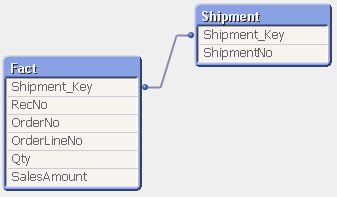Unlock a world of possibilities! Login now and discover the exclusive benefits awaiting you.
- Qlik Community
- :
- All Forums
- :
- QlikView App Dev
- :
- Re: Counting issues in table object
- Subscribe to RSS Feed
- Mark Topic as New
- Mark Topic as Read
- Float this Topic for Current User
- Bookmark
- Subscribe
- Mute
- Printer Friendly Page
- Mark as New
- Bookmark
- Subscribe
- Mute
- Subscribe to RSS Feed
- Permalink
- Report Inappropriate Content
Counting issues in table object
Hi all,
I have problem counting when including a field from a dimension table. I have an order number with some lines in my fact table. The order total qty is 200, and the correct total sales amount is 136 240,-. Below is my table object. As you can see, there's a duplicate on order line 50000. That's because this line is connected to two different shipments. If I remove the ShipmentNo field the calculations will be correct.

This is my data model and code (simplified):

Fact:
Load * Inline [
RecNo, OrderNo, OrderLineNo, Shipment_Key, Qty, SalesAmount
1, KO01542142, 10000, 1, 40, 0
2, KO01542142, 30000, 2, 40, 6600
3, KO01542142, 40000, 3, 40, 4000
4, KO01542142, 50000, 4, 40, 6000
5, KO01542142, 80000, 5, 10, 29910
6, KO01542142, 80000, 5, 10, 29910
7, KO01542142, 80000, 5, 10, 29910
8, KO01542142, 80000, 5, 10, 29910
];
Shipment:
Load * Inline [
Shipment_Key, ShipmentNo
1, -
2, LO01665695
3, LO01665633
4, LO01590308
4, LO01672135
5, LO01686726
];
Can I somehow make a calculation in my table object that solves this problem..? Don't wanna change my data model.
3 000,- at each row is good enough. I have tried Sum(SalesAmount) / Count(OrderLineNo) but that will not be correct for line 8000, which has multiple rows in my fact table...
This must be a quite common problem I guess...
Please answer with your suggestions ![]()
Best regards
Filip
- Tags:
- counting
Accepted Solutions
- Mark as New
- Bookmark
- Subscribe
- Mute
- Subscribe to RSS Feed
- Permalink
- Report Inappropriate Content
Rather than using ShipmentNo as a dimension, use Concat(ShipmentNo, ', ') as an expression,
- Mark as New
- Bookmark
- Subscribe
- Mute
- Subscribe to RSS Feed
- Permalink
- Report Inappropriate Content
Hi Filip,
is it correct that you have 2 different shipment numbers for shipment key 4 ?
Andy
- Mark as New
- Bookmark
- Subscribe
- Mute
- Subscribe to RSS Feed
- Permalink
- Report Inappropriate Content
Hi
Try like this
| OrderNo | OrderLineNo | ShipmentNo | =SUm(Qty) | =If(RowNo() = 0 or IsNull(RowNo()), Sum(SalesAmount), Sum(SalesAmount) / Count(TOTAL<OrderNo, OrderLineNo> ShipmentNo)) |
|---|---|---|---|---|
| 200 | 136240 | |||
| KO01542142 | 10000 | - | 40 | 0 |
| KO01542142 | 30000 | LO01665695 | 40 | 6600 |
| KO01542142 | 40000 | LO01665633 | 40 | 4000 |
| KO01542142 | 50000 | LO01590308 | 40 | 3000 |
| KO01542142 | 50000 | LO01672135 | 40 | 3000 |
| KO01542142 | 80000 | LO01686726 | 40 | 119640 |
Please close the thread by marking correct answer & give likes if you like the post.
- Mark as New
- Bookmark
- Subscribe
- Mute
- Subscribe to RSS Feed
- Permalink
- Report Inappropriate Content
Rather than using ShipmentNo as a dimension, use Concat(ShipmentNo, ', ') as an expression,
- Mark as New
- Bookmark
- Subscribe
- Mute
- Subscribe to RSS Feed
- Permalink
- Report Inappropriate Content
If you use a straight table chart with total mode expression total, I can't reproduce your results:
| OrderNo | OrderLineNo | ShipmentNo | Sum(Qty) | Sum(SalesAmount) |
|---|---|---|---|---|
| 200 | 136240 | |||
| KO01542142 | 10000 | - | 40 | 0 |
| KO01542142 | 30000 | LO01665695 | 40 | 6600 |
| KO01542142 | 40000 | LO01665633 | 40 | 4000 |
| KO01542142 | 50000 | LO01590308 | 40 | 6000 |
| KO01542142 | 50000 | LO01672135 | 40 | 6000 |
| KO01542142 | 80000 | LO01686726 | 40 | 119640 |
- Mark as New
- Bookmark
- Subscribe
- Mute
- Subscribe to RSS Feed
- Permalink
- Report Inappropriate Content
Thank you for this solution, it fits me best. Didn't think in this way..
Best,
Filip